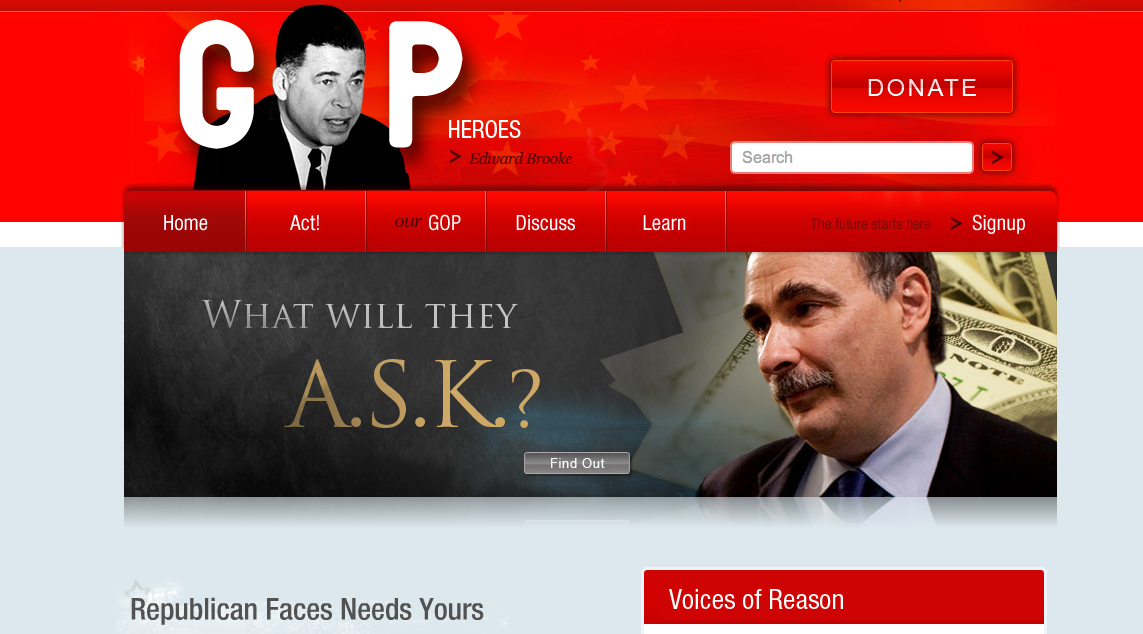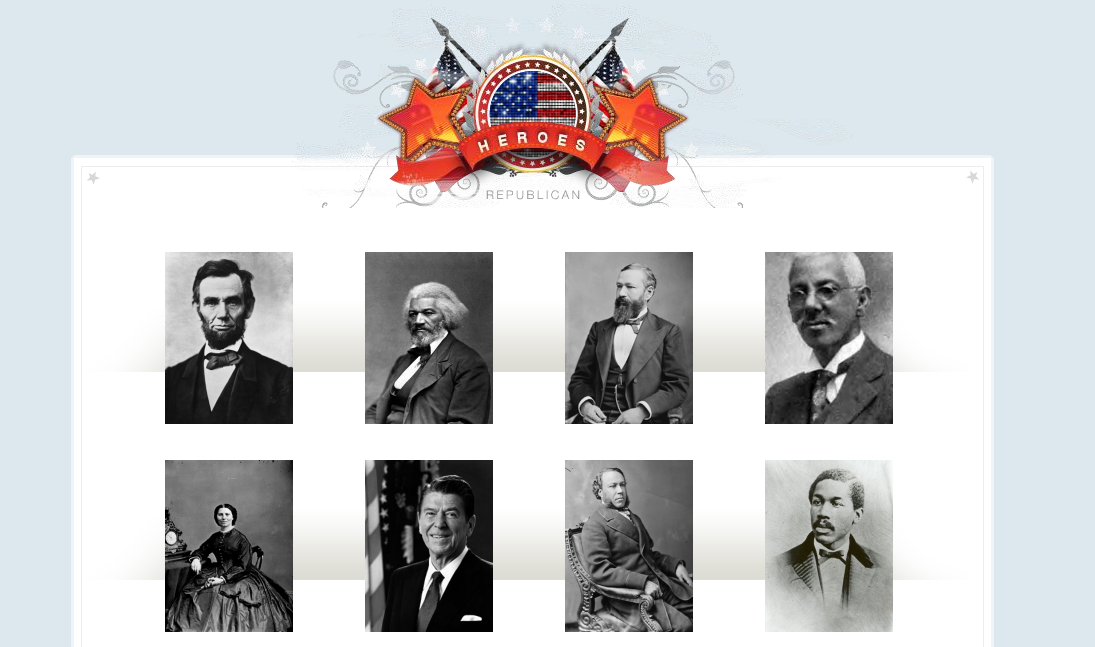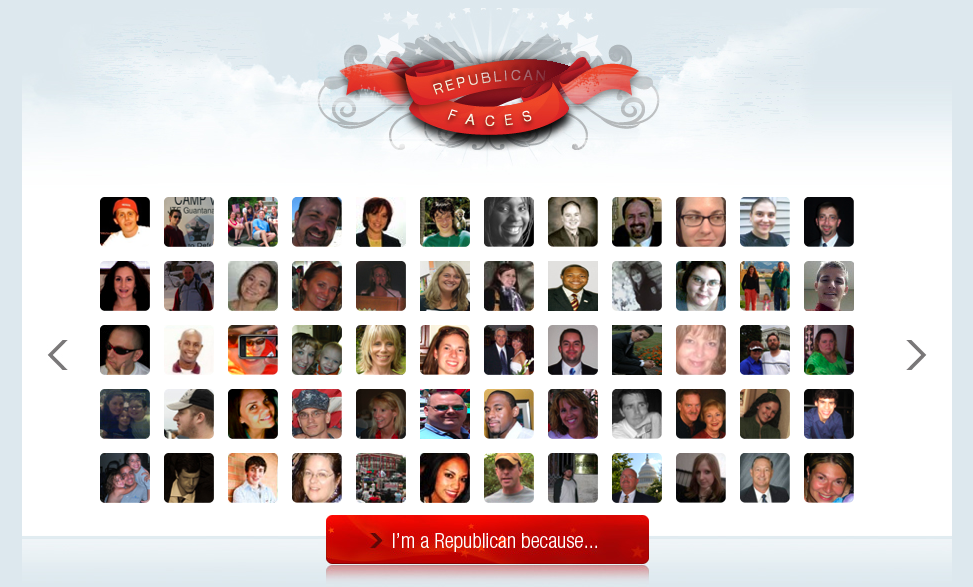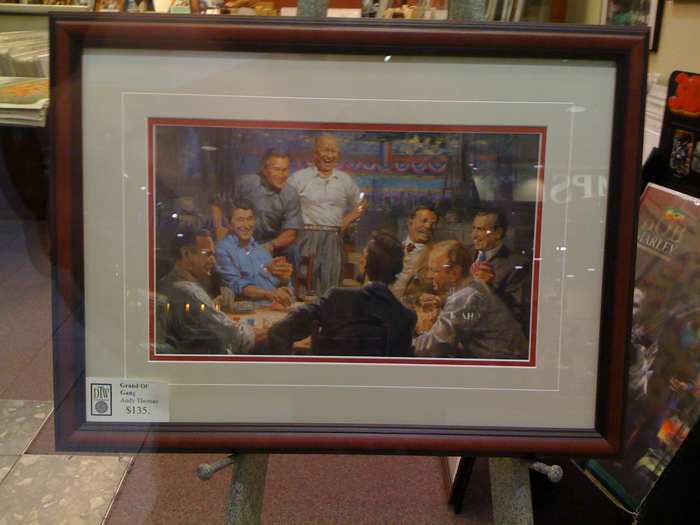
Screen shot of gop.com
This past week the Republican National Committee launched its new websiteand found itself mired in technical difficulties and contending with several scathing reviews. The website features a blog by chairman Michael Steele and several links to other forms of new social media as part of the GOP's most recent attempt to revamp its image. I, however, was drawn to two different galleries of photographs featured on the website: the "Patriots: American Heroes and Famous Republicans" page which seems to tell a particular history of the party through the several black and white photographs it features and the "Republican Faces" page which features the personal photographs and testimonials uploaded by visitors to the site.
The creators of the site collected the photographs of several prominent Republicans and placed them in the gallery of "Patriots: American Heroes and Famous Republicans." These images are all in black and white--both the portraits of Abraham Lincoln and Frederick Douglass (as, of course they must be) but also the portrait of Ronald Reagan--and are arranged beneath a glittering banner proclaiming those pictured heroes and above text that emphasizes the "rich history of men and women who fought for freedom and equality."

Screen shot of gop.com
In an attempt to characterize the party as having held a long history of diversity, thirteen of the eighteen portraits feature women or people of color. Critics balked at the inclusion of a portrait of Jackie Robinson, who helped campaign for Nixon but who was also a registered independent who expressed grave misgivings about the party's policies during the Civil Rights Era and the turn toward Goldwater in 1964. I was also intrigued by the narrative photographs construct in linking the 19th century Republican party of Abe Lincoln and Hiram Revels to the party of Ronald Reagan and Dwight Eisenhower. While it is true that all of these images depict Republicans, the layout of the images suggests that these illustrious men and women were all the same type of Republican and elides the massive changes within the party over the many decades documented in this "rich history."
Visitors to the site can find their way to the gallery of heroes by clicking on the "Learn" tab but they can also end up there by clicking on a 19th century photograph of Pinckney Pinchback (state senator of Louisiana in 1871) placed within a graphic so that it appears to be a polaroid. An anachronistic choice for a page that privileges the "history" of the party and an odd choice for a website that otherwise privileges social media.

Screen shot of gop.com
That emphasis on social media includes a section in which visitors to the site can upload their personal portraits and twitter feeds. The "Republican Faces" page includes a gallery not unlike that of the "Famous Heroes" and so suggests that this diverse and democratic (small "d") collection of party members falls in line with the longer narrative of the history of the party. Moreover, the banner on the homepage features a constantly changing "face of the party" within the "O" of the GOP and the portraits there are pulled from both the historical and the contemporary galleries. Interestingly, the link on the homepage to the page of "Republican Faces" is currently centered beneath a call from Michael Steele to submit a personal photograph and a testimonial as why one is a Republican. To participate viewers select a button labelled "Take Action." While I have my misgivings about whether uploading personal photography can be a form of social action, and about the narrative of inclusion and diversity depicted on the site, I can certainly appreciate the rhetoric at work here.
Comments
One of these is not like the other
It's also illuminating to compare the gallery above with this image. I took this picture at the mall last week, outside of one of those nostalgia shops. (In fairness, right next to it there was a similar picture of Democratic presidents.) The grouping here completely baffles me; for example, why is Nixon there?
I took this picture at the mall last week, outside of one of those nostalgia shops. (In fairness, right next to it there was a similar picture of Democratic presidents.) The grouping here completely baffles me; for example, why is Nixon there?
Down with GOP (Yeah, You Know Me)
Andi, I'm glad you pointed this out! I am an occasional reader of Wonkette, and so their satiric coverage of Michael Steele's contributions to it did not escape my notice. I think you make an interesting point about how publicly performing an identity is often seen as equivalent to performing politically--and my mind is racing trying to think about whether Hannah Arendt might consider such work action, or what Michael Warner would think of this. (Sorry, my class readings are spilling over into my thoughts here.) I like how using the heads as the Os of GOP seems to literally incorporate individuals into the GOP iconography--I am physically GOP, as it were. I wonder how that fits into this as well.